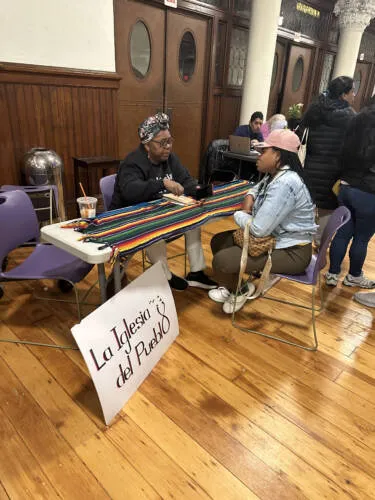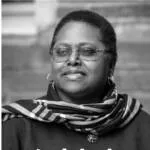This piece is part of an ongoing series focused on the themes of “healing” and “repair.” Follow the blog or check our Facebook page to see the other posts in the series as they’re published bimonthly.

"More than any other nation on Earth, America has constantly drawn strength and spirit from wave after wave of immigrants. In each generation, they have proved to be the most restless, the most adventurous, the most innovative, the most industrious people." Former President Bill Clinton
The immigrant community is a community in need of healing and reparation. Immigrants have played a crucial role in the building and flourishing of this nation through their hard labor, resiliency, and dedication. Despite the repeated mantra that the USA is a nation of immigrants, people seem to forget or ignore this fact. We are a country of immigrants built on stolen land by enslaved hands. Despite this heavy reality, immigrants tend to be treated like second-class citizens. These impoverished black and brown immigrants are also portrayed as a threat to society.
From the spring of 2022 until now, we have been in the middle of yet another immigration wave. State governors are "shipping" immigrants from one state to another as if we are mere objects. They are sending immigrants to those cities that, in a spirit of reparation and healing, have declared themselves "sanctuary cities,” pledging to welcome and protect immigrants' lives. In doing so, these cities are very much in line with the Biblical mandate about immigrants. The Hebrew Bible and the New Testament call for justice and protection of immigrants; Leviticus 19:33-34 is an excellent example of that:
"When a foreigner resides among you in your land, do not mistreat them. They must be treated as your native-born. Love them as yourself, for you were foreigners in Egypt."Leviticus 19:33-34
One of the places where immigrants have been sent is New York City, where I live and have called home since arriving from my native Dominican Republic three decades ago. New York City is also where I minister to newly arrived immigrants through La Iglesia del Pueblo, a 1001 New Worshiping Community. Founded in 2020 as a virtual community by a group of leaders of the Poor People's Campaign: A National Call for a Moral Revival, our community had the support of the Kairos Center for Religious Human Rights. As the country began to open up after the pandemic, leaders of La Iglesia del Pueblo started envisioning what our in-person community would look like. This coincides with the new immigration wave I mentioned before. We saw this event as an opportunity, not merely a crisis, and members of our community began to volunteer, welcoming the buses of migrants arriving at Port Authority Terminal in midtown Manhattan.

Eventually, we partnered with St.Paul & St. Andrew UM Church. We joined their Mondays Immigrants Resource Fair, known as "Miracles Mondays”; here, we provide spiritual and emotional support to this community while they receive a variety of services, such as legal services, information and orientation about where to access essential services. There is also clothing distribution and food is shared. Here, we started building our "new" Iglesia del Pueblo community. We created a chat group where we continued to communicate throughout the week.
We started coordinating activities, sharing resources, and meeting specific individual needs when possible. This is our Iglesia del Pueblo now – a church born amid people's struggle for a better life. We learned about their journey to the USA, where they crossed different countries, rivers and deserts, including the Darien jungle. They have stories of near-death experiences, violence and violations, yet they also have related stories of solidarity, resilience, life, and faith and hope. During these informal conversations, the idea of forming workers’ cooperatives started shaping up, and now we are about to complete the last session of our Workers Cooperative Academy.
While writing this piece and reflecting on my personal experience here, I feel that I am on both sides of the coin because by opening its doors and hearts to newly arrived immigrants and to La Iglesia del Pueblo, St. Paul & St. Andrews has also opened their hearts to me, myself an immigrant, Latina, black, woman, poor. Someone who, like our immigrant friends, has experienced discrimination, racism and rejection from both the secular and religious sectors of society.

Before finally settling at this church, I knocked on many doors, including my "church home," looking for a gathering place for this community. We only found rejection and excuses.
That is why my challenge to you who are reading these lines is to look up and listen. Outside the safety and comfort of your temple on every side, there are hundreds of immigrants searching, longing for a place to experience community and to re-create their lost home.
Rest assured that by doing this, you become an agent of healing and reparation.
Arelis Figueroa meets with a woman at La Iglesia del Pueblo in Manhattan. (Photo credit: Brent Ness.

Arelis M. Figueroa is the executive director and lead pastor of La Iglesia del Pueblo. She is originally from the Dominican Republic and has worked with marginalized communities in New York City for over 30 years. Arelis is a pastor, educator, activist and community organizer. She co-founded La Iglesia del Pueblo, a 1001 New Worshiping Community and a Matthew 25 Congregation founded in the tradition of Freedom Church of the Poor.
You may freely reuse and distribute this article in its entirety for non-commercial purposes in any medium. Please include author attribution, photography credits, and a link to the original article. This work is licensed under a Creative Commons Attribution-NonCommercial-NoDeratives 4.0 International License.

